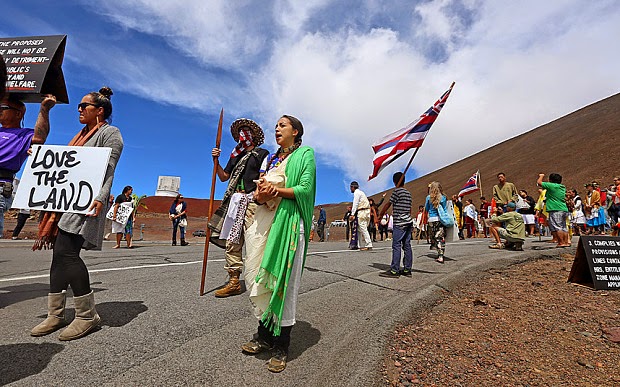""If completed, the Thirty Meter Telescope (TMT), to be built atop Hawaii’s dormant Mauna Kea volcano, will be one of the largest and most powerful telescopes in the world. According to the project’s organizers, the TMT “will enable astronomers to study objects in our own solar system and stars throughout our Milky Way and its neighboring galaxies, and forming galaxies at the very edge of the observable universe, near the beginning of time.”
It will be quite the scientific feat, and undoubtedly a boon to astronomical institutions the world over. The governments of the United States, China, Japan, India, and Canada have all contributed funds in hopes of eventually utilizing research undertaken at the TMT observatory, which is affiliated with the California Institute of Technology.
But building the TMT is proving to be a costly project—in more ways than one. The estimated bill weighs in at a whopping $1.4 billion. But for native Hawaiians, the financial costs pale in comparison to the cultural ones.
The summit of Mauna Kea is considered sacred ground by practitioners of the native Hawaiian religion, who believe it to be the otherworldly temple of Wa Akua, the creator-deity. According to a report compiled by Harvard University’s Pluralism Project, “In ancient Polynesian oral history, the summit is considered the meeting place of Earth Mother and Sky Father, parents of the entire human race.”
“It’s our garden of Eden,” an unnamed native man told researchers. “Though such an analogy defies the specificity of the place for native Hawaiians,” the Harvard authors qualify.
Dozens of demonstrators, most of them native-Hawaiian, first ascended to the TMT worksite at the end of Mar. 2015, halting preliminary construction. A number of celebrities, including those of native-Hawaiian descent like Game of Thrones’s Jason Momoa and singer Nicole Scherzinger, have since joined the effort online, posting self-portraits to Instagram with “We Are Mauna Kea” scrawled across arms and collarbones.
“Our stance is not against the science,” Lanakila Mangauil, 27, one of the Mauna Kea protesters, told The Hawaii Tribune Herald. “It’s not against the science. It’s not against the TMT itself. It’s against their choice of place.”
So what inspired this controversial “choice of place”? The short answer: convenience.
Mauna Kea is home to a larger complex of observatories—13, to be exact—operated by astronomers from roughly a dozen different countries. (Most of these were met with similar protests at the time of construction—though none as viral as the one unfolding now.) This means that TMT astronomers would have access to an abundance of scientific and technological resources. According to the University of Hawaii’s Institute for Astronomy, which also operates an observatory atop Mauna Kea, “the combined light-gathering power of the telescopes on Mauna Kea is fifteen times greater than that of the Palomar telescope in California—or many years the world’s largest—and sixty times greater than that of the Hubble Space Telescope.""






No comments:
Post a Comment